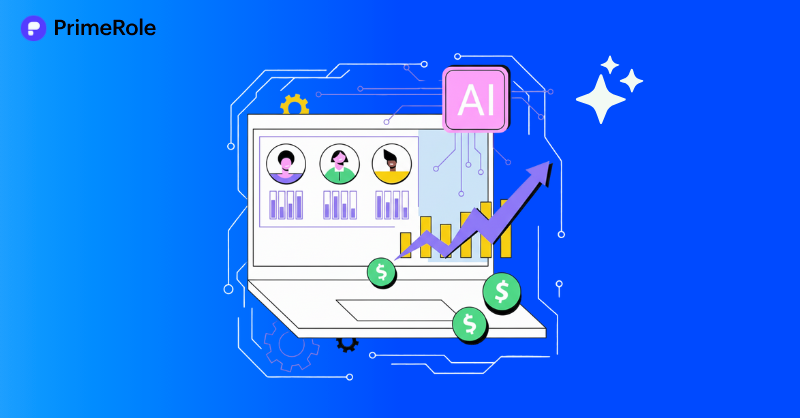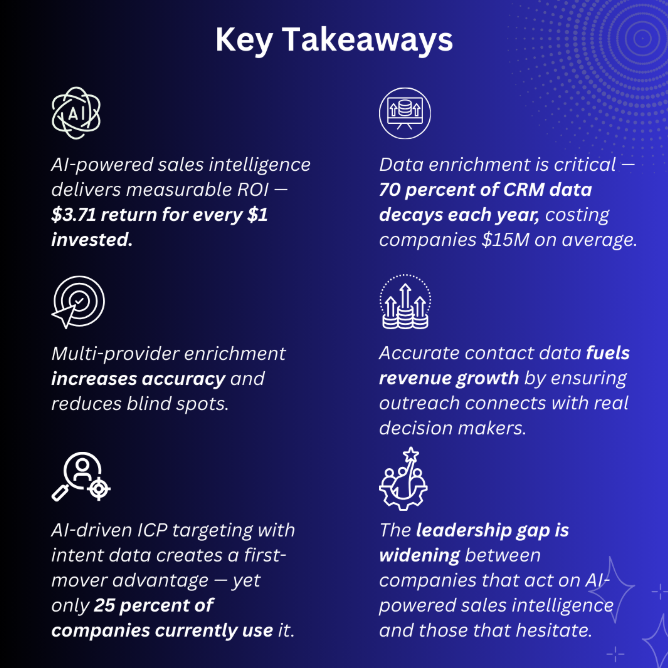
Sales intelligence is no longer optional for B2B leaders. It has become the deciding factor between companies that accelerate revenue and those that struggle with inefficiency. Yet the traditional model of static databases and outdated CRM records is broken. Artificial intelligence is fixing this by turning raw data into precise, real-time insights that directly fuel growth. For B2B leaders, the choice is stark: embrace AI-powered sales intelligence now or risk losing competitive ground.

What Is Sales Intelligence and Why Does It Matter for Growth?
Sales intelligence is the process of collecting, enriching, and analyzing customer and prospect data to improve sales efficiency. In complex B2B buying cycles, sales intelligence is crucial because it determines who to target, how to engage them, and when to take action. The numbers prove its value.
A 2024 Salesforce study found that 83 percent of sales teams using AI reported revenue growth compared to 66 percent of those without it.
Even more striking, for every $1 spent on Generative AI, adopters saw an average return of $3.71. Beyond ROI, productivity gains are substantial: AI users save an average of 12 hours per week by automating repetitive tasks. That time translates directly into more conversations with qualified buyers.
Why is Data Enrichment Essential for Sales Intelligence?
Data enrichment ensures that sales teams are working with complete, accurate, and up-to-date information. Without it, even the most advanced AI models deliver poor insights because they are built on flawed foundations.
The urgency is clear. Gartner research indicates that 70 percent of CRM data becomes outdated or inaccurate within one year, resulting in an average annual cost of $15 million to companies.
Enrichment solves this decay by continuously validating and updating contact details and company profiles. The result is fewer wasted outreach attempts, higher engagement rates, and faster deal cycles.
How Does AI Enrichment Improve Accuracy?
Relying on a single enrichment vendor creates blind spots because no provider has full global coverage. Multi-provider enrichment combines data streams from several vendors, reconciles discrepancies, and produces a more complete and accurate record.
AI strengthens this process by comparing inputs, detecting anomalies, and selecting the most reliable attributes. The outcome is greater contact data accuracy and fewer missed opportunities. For B2B sales teams, this means less time spent on low-quality leads and more time engaging decision makers who matter.
Contact Data Accuracy Drives Revenue
Contact data accuracy is not just an operational detail; it is a growth driver. Every inaccurate email or outdated phone number represents a lost opportunity and a damaged brand impression.
AI-powered validation tools help by monitoring and refreshing contact data in real time. This is critical in industries where job roles change frequently. With accurate contact data, teams reach the right people at the right time, which directly impacts conversion rates and overall revenue performance.
How is ICP Targeting Changing with AI?
Defining an Ideal Customer Profile (ICP) used to mean focusing on company size, revenue, or industry. While useful, this static approach fails to reflect real buyer intent.
Forrester found that companies using intent data are 2.5 times more likely to exceed sales goals, yet only 25 percent of B2B organizations currently leverage it. This gap creates a major first-mover advantage. Reps confirm its value, with 65 percent saying buyer intent data significantly improves their ability to close deals.
AI makes ICP targeting dynamic by analyzing behavioral signals, intent data, and historical win patterns. Instead of casting a wide net, teams can zero in on accounts that are actively signaling readiness to buy. The effect is better alignment between marketing and sales, higher pipeline quality, and faster revenue growth.
How Can Organizations Move from Insights to Execution?
The real power of sales intelligence comes when insights are turned into action. AI platforms now automate lead scoring, trigger personalized campaigns, and even provide real-time recommendations during prospect conversations.
This shift moves teams from reactive selling to proactive engagement. Instead of guessing who to contact, reps are guided by data-backed recommendations. This not only improves efficiency but also elevates the quality of buyer interactions.
What is the Leadership Opportunity in Sales Intelligence?
The research shows the opportunity is urgent and measurable. Companies using AI for sales intelligence are already seeing revenue growth, stronger pipelines, and better productivity. Those who delay risk falling behind as their data decays and competitors capture first-mover advantage with intent-driven targeting.
Executives must recognize that sales intelligence is no longer a support function but a core growth driver. Investing in AI-powered enrichment, accuracy, and targeting is a leadership decision that determines whether organizations will lead their markets or lose ground to faster, more data-driven competitors.
Sales intelligence is broken in its traditional form. Static databases, single-source enrichment, and outdated targeting models no longer meet the demands of competitive B2B markets. AI fixes these problems by enriching data, ensuring accuracy, and aligning targeting with real buyer intent.
The evidence is clear: AI adoption leads to faster revenue growth, higher productivity, and stronger customer engagement. The leaders of tomorrow will be the ones who act today, turning sales intelligence into the engine of sustainable B2B growth.
